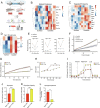Metabolic reprogramming underlies cavefish muscular endurance despite loss of muscle mass and contractility
- PMID: 36693105
- PMCID: PMC9945943
- DOI: 10.1073/pnas.2204427120
Metabolic reprogramming underlies cavefish muscular endurance despite loss of muscle mass and contractility
Abstract
Physical inactivity is a scourge to human health, promoting metabolic disease and muscle wasting. Interestingly, multiple ecological niches have relaxed investment into physical activity, providing an evolutionary perspective into the effect of adaptive physical inactivity on tissue homeostasis. One such example, the Mexican cavefish Astyanax mexicanus, has lost moderate-to-vigorous activity following cave colonization, reaching basal swim speeds ~3.7-fold slower than their river-dwelling counterpart. This change in behavior is accompanied by a marked shift in body composition, decreasing total muscle mass and increasing fat mass. This shift persisted at the single muscle fiber level via increased lipid and sugar accumulation at the expense of myofibrillar volume. Transcriptomic analysis of laboratory-reared and wild-caught cavefish indicated that this shift is driven by increased expression of pparγ-the master regulator of adipogenesis-with a simultaneous decrease in fast myosin heavy chain expression. Ex vivo and in vivo analysis confirmed that these investment strategies come with a functional trade-off, decreasing cavefish muscle fiber shortening velocity, time to maximal force, and ultimately maximal swimming speed. Despite this, cavefish displayed a striking degree of muscular endurance, reaching maximal swim speeds ~3.5-fold faster than their basal swim speeds. Multi-omic analysis suggested metabolic reprogramming, specifically phosphorylation of Pgm1-Threonine 19, as a key component enhancing cavefish glycogen metabolism and sustained muscle contraction. Collectively, we reveal broad skeletal muscle changes following cave colonization, displaying an adaptive skeletal muscle phenotype reminiscent to mammalian disuse and high-fat models while simultaneously maintaining a unique capacity for sustained muscle contraction via enhanced glycogen metabolism.
Keywords: evolutionary physiology; physical activity; skeletal muscle metabolism.
Conflict of interest statement
The authors declare no competing interest.
Figures




Similar articles
-
Distinct genetic architecture underlies the emergence of sleep loss and prey-seeking behavior in the Mexican cavefish.BMC Biol. 2015 Feb 20;13:15. doi: 10.1186/s12915-015-0119-3. BMC Biol. 2015. PMID: 25761998 Free PMC article.
-
Enhanced lipogenesis through Pparγ helps cavefish adapt to food scarcity.Curr Biol. 2022 May 23;32(10):2272-2280.e6. doi: 10.1016/j.cub.2022.03.038. Epub 2022 Apr 6. Curr Biol. 2022. PMID: 35390280 Free PMC article.
-
Genetic mapping of metabolic traits in the blind Mexican cavefish reveals sex-dependent quantitative trait loci associated with cave adaptation.BMC Ecol Evol. 2021 May 21;21(1):94. doi: 10.1186/s12862-021-01823-8. BMC Ecol Evol. 2021. PMID: 34020589 Free PMC article.
-
Towards an integrated approach to understand Mexican cavefish evolution.Biol Lett. 2018 Aug;14(8):20180101. doi: 10.1098/rsbl.2018.0101. Biol Lett. 2018. PMID: 30089659 Free PMC article. Review.
-
Utilizing the blind cavefish Astyanax mexicanus to understand the genetic basis of behavioral evolution.J Exp Biol. 2020 Feb 7;223(Pt Suppl 1):jeb208835. doi: 10.1242/jeb.208835. J Exp Biol. 2020. PMID: 32034044 Review.
Cited by
-
Host evolution shapes gut microbiome composition in Astyanax mexicanus.Ecol Evol. 2024 Apr 1;14(4):e11192. doi: 10.1002/ece3.11192. eCollection 2024 Apr. Ecol Evol. 2024. PMID: 38571802 Free PMC article.
-
3D spheroid culturing of Astyanax mexicanus liver-derived cell lines recapitulates distinct transcriptomic and metabolic states of in vivo tissue environment.J Exp Zool B Mol Dev Evol. 2024 May;342(3):301-312. doi: 10.1002/jez.b.23236. Epub 2024 Jan 8. J Exp Zool B Mol Dev Evol. 2024. PMID: 38192038 Free PMC article.
-
Cavefish mount a rapid and sustained regenerative response following skeletal muscle injury.Zool Res. 2023 Jul 18;44(4):776-778. doi: 10.24272/j.issn.2095-8137.2022.486. Zool Res. 2023. PMID: 37464934 Free PMC article. No abstract available.
-
Skeletal muscle myosin heavy chain protein fragmentation as a potential marker of protein degradation in response to resistance training and disuse atrophy.bioRxiv [Preprint]. 2024 May 25:2024.05.24.595789. doi: 10.1101/2024.05.24.595789. bioRxiv. 2024. Update in: Exp Physiol. 2024 Oct;109(10):1739-1754. doi: 10.1113/EP092093. PMID: 38826385 Free PMC article. Updated. Preprint.
-
Proteomics Analysis of R-Ras Deficiency in Oxygen Induced Retinopathy.Int J Mol Sci. 2023 Apr 26;24(9):7914. doi: 10.3390/ijms24097914. Int J Mol Sci. 2023. PMID: 37175621 Free PMC article.
References
-
- Kaji T., Anker A., Wirkner C. S., Palmer A. R., Parallel saltational evolution of ultrafast movements in snapping shrimp claws. Curr. Biol. 28, 106–113.e104 (2018). - PubMed
-
- Dickinson M. H., et al. , How animals move: An integrative view. Science 288, 100–106 (2000). - PubMed
-
- Fröbert O., Frøbert A. M., Kindberg J., Arnemo J. M., Overgaard M. T., The brown bear as a translational model for sedentary lifestyle-related diseases. J. Intern. Med. 287, 263–270 (2020). - PubMed
Publication types
MeSH terms
Substances
Grants and funding
LinkOut - more resources
Full Text Sources
Miscellaneous

